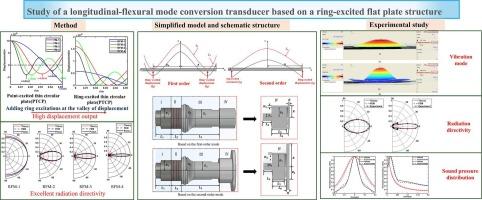Study of a longitudinal-flexural mode conversion transducer based on a ring-excited flat plate structure
IF 3.4
2区 物理与天体物理
Q1 ACOUSTICS
引用次数: 0
Abstract
Air-coupled transducer equipped with a flexural vibration radiator find application in an extensive range of non-destructive material testing, material monitoring, and long-range acoustic energy transmission. In this paper, a class of air-coupled longitudinal-flexural mode conversion transducers with a ring-excited thin circular plate (RTCP) radiator is studied. Based on thin plate vibration theory, the analytical solutions for the radiation directivity of the proposed transducer based on different vibration mode were derived. The finite element models of the RTCPs were established to analyse and discuss the effect of ring excitation on the vibration modes and their radiation directivity. The computational results demonstrate that the directivity of a flat plate radiator could be enhanced by the addition of a ring excitation at the valley of the normal displacement curve for all orders of axisymmetric flexural modes. The RTCP is distinguished by the absence of nodal circles, a lower frequency and a significantly larger ANVD when compared to those observed in the point-excited thin circular plate (PTCP). Furthermore, RTCP exhibits directivity comparable to that of a piston source with equivalent dimensions, yet possesses a larger ANVD. A comparison was made between the RTCP and two other radiators, an existing stepped plate radiator (SP) and a ring excitation fixed boundary radiator (RFP). The results of this comparison demonstrate that the RTCP has a larger ANVD, a narrower beamwidth (BW) of the main lobe, a smaller amplitude (AM) of the side lobe, and the capacity to radiate over a longer distance with a narrower beamwidth. Finally, two transducer prototypes were fabricated, after which the resonant frequencies, vibration modes, radiation directivity and radiated sound field were measured. The findings of this study confirm that the vibration modes and radiation directivity patterns obtained by the three methods (theoretical, finite element, and experimental) are consistent. The designed transducers have been shown to possess exceptional radiation directivity.

基于环激励平板结构的纵弯模态转换换能器的研究
配有弯曲振动散热器的空气耦合换能器广泛应用于无损材料检测,材料监测和远程声能传输。本文研究了一类带环形激励薄板(RTCP)散热器的空气耦合纵弯模式转换换能器。基于薄板振动理论,推导了不同振动模式下换能器辐射指向性的解析解。建立了rtcp的有限元模型,分析和讨论了环激励对rtcp振动模态及其辐射指向性的影响。计算结果表明,对于轴对称弯曲模态的所有阶,在法向位移曲线谷处加环激励可以增强平板辐射体的指向性。与点激发薄圆板(PTCP)相比,RTCP的特点是没有节圆,频率更低,ANVD明显更大。此外,RTCP具有与同等尺寸的活塞源相当的方向性,但具有更大的ANVD。将RTCP与现有的阶梯板式散热器(SP)和环形激励固定边界散热器(RFP)进行了比较。比较结果表明,RTCP具有较大的ANVD、较窄的主瓣波束宽度(BW)、较小的副瓣波幅(AM)以及较窄波束宽度下较长距离辐射的能力。最后,制作了两个换能器原型,并对其谐振频率、振动模式、辐射指向性和辐射声场进行了测量。本研究结果证实了三种方法(理论、有限元和实验)得到的振动模态和辐射指向性图是一致的。所设计的换能器已被证明具有特殊的辐射指向性。
本文章由计算机程序翻译,如有差异,请以英文原文为准。
求助全文
约1分钟内获得全文
求助全文
来源期刊

Applied Acoustics
物理-声学
CiteScore
7.40
自引率
11.80%
发文量
618
审稿时长
7.5 months
期刊介绍:
Since its launch in 1968, Applied Acoustics has been publishing high quality research papers providing state-of-the-art coverage of research findings for engineers and scientists involved in applications of acoustics in the widest sense.
Applied Acoustics looks not only at recent developments in the understanding of acoustics but also at ways of exploiting that understanding. The Journal aims to encourage the exchange of practical experience through publication and in so doing creates a fund of technological information that can be used for solving related problems. The presentation of information in graphical or tabular form is especially encouraged. If a report of a mathematical development is a necessary part of a paper it is important to ensure that it is there only as an integral part of a practical solution to a problem and is supported by data. Applied Acoustics encourages the exchange of practical experience in the following ways: • Complete Papers • Short Technical Notes • Review Articles; and thereby provides a wealth of technological information that can be used to solve related problems.
Manuscripts that address all fields of applications of acoustics ranging from medicine and NDT to the environment and buildings are welcome.
 求助内容:
求助内容: 应助结果提醒方式:
应助结果提醒方式:


